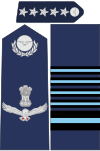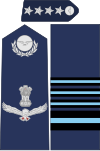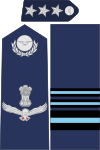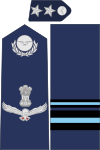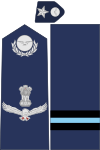Air marshal is an air-officer rank used by some air forces, with origins from the Royal Air Force. The rank is used by the air forces of many countries which have historical British influence, including many Commonwealth nations. The rank is usually equivalent to a vice admiral or a lieutenant general.
Air chief marshal is a high-ranking air officer rank used by some air forces, with origins from the Royal Air Force. The rank is used by air forces of many countries that have historical British influence. This rank is also equivalent to an Admiral in a navy or a full general in an army or other nations' air forces.
Chief Warrant officer is a senior warrant officer rank, used in many countries.
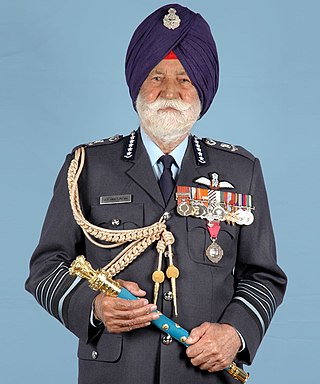
Marshal of the Indian Air Force Arjan Singh, was a senior air officer of the Indian Air Force. He served as the 3rd Chief of the Air Staff from 1964 to 1969, leading the Air Force through the Indo-Pakistani War of 1965. He was the first and only officer of the Indian Air Force (IAF) to be promoted to five-star rank as Marshal of the Indian Air Force, equal to the army rank of Field Marshal.
The Indian Army, the land component of the Indian Armed Forces, follows a certain hierarchy of rank designations and insignia derived from the erstwhile British Indian Army (BIA).
The Indian Navy (IN), the naval component of the Indian Armed Forces follows a certain hierarchy of rank designations and insignia derived from the erstwhile Royal Indian Navy (RIN).

Air Chief Marshal Pratap Chandra Lal, DFC was the Chief of Air Staff (CAS) of the Indian Air Force (IAF) during the Indo-Pakistani War of 1971. He served in the IAF from 1939 until his retirement in 1973. He was the CAS at the time of Operation Chengiz Khan, the preemptive strikes that were carried out by the Pakistan Air Force (PAF) that marked the formal initiation of hostilities of the war.
Master warrant officer (MWO) is a senior military rank in the Bangladesh Armed Forces, the Canadian Forces, Singapore Armed Forces, the South African National Defence Force and the Israel Defense Forces.

The Vice Chief of the Air Staff (VCAS) is the deputy to the Chief of the Air Staff of India and second-highest ranking officer of the Indian Air Force. The VCAS is a PSO at Air Headquarters at New Delhi. In the event that the Chief of Air Staff (CAS) is absent or is unable to perform his duties, the VCAS assumes the duties and responsibilities of the CAS. The VCAS is normally held by an officer of three star rank and is held by an air officer of the rank of Air Marshal.

The Royal Indian Air Force (RIAF) was the aerial force of British India and later the Dominion of India. Along with the Indian Army, and Royal Indian Navy, it was one of the Armed Forces of British Indian Empire.

Air Marshal Subroto Mukerjee OBE was an Indian military officer who was the first Indian Commander-in-Chief (C-in-C) of the Indian Air Force. He was awarded several honours during the course of a three-decade-long career, ended by his untimely demise in 1960. He has been called the Father of the Indian Air Force.

The Chief of the Air Staff (CAS) is the office of the professional head of the Indian Air Force (IAF), the aerial branch of the Indian Armed Forces. Customarily held by a four-star air chief marshal, the CAS is the senior-most operational officer of the IAF, mandated with the responsibilities of supervising the force's overall functioning during states of peace and wartime, committing to the establishment-cum-continuity of air deterrence and executing India's security objectives vis-à-vis the preservation of the country's air sovereignty. Also a permanent member of the Chiefs of Staff Committee (COSC) and the National Security Council (NSC), the CAS also bears the responsibility of advising the nation's civilian leadership i.e., the Government of India on all matters privy to the IAF.

A five-star rank is the highest military rank in many countries. The rank is that of the most senior operational military commanders, and within NATO's standard rank scale it is designated by the code OF-10. Not all armed forces have such a rank, and in those that do the actual insignia of the five-star ranks may not contain five stars. For example: the insignia for the French OF-10 rank maréchal de France contains seven stars; the insignia for the Portuguese marechal contains four gold stars. The stars used on the various Commonwealth of Nations rank insignias are sometimes colloquially referred to as pips, but in fact either are stars of the orders of the Garter, Thistle or Bath or are Eversleigh stars, depending on the wearer's original regiment or corps, and are used in combination with other heraldic items, such as batons, crowns, swords or maple leaves.

Gorget patches are an insignia in the form of paired patches of cloth or metal on the collar of a uniform (gorget), used in the military and civil service in some countries. Collar tabs sign the military rank, the rank of civil service, the military unit, the office (department) or the branch of the armed forces and the arm of service.

Marshal of the Air Force is a five star rank and the highest attainable rank in the Indian Air Force.

Air Marshal Ramaswamy Rajaram, DFC (1917–1969) was a senior officer in the Indian Air Force. He died in harness while serving as the Vice Chief of Air Staff (VCAS) of the Indian Air Force. He was the Air Officer Commanding-in-Chief Western Air Command during the Indo-Pakistani War of 1965.

Admiral is a four-star naval flag officer rank in the Indian Navy. It is the highest active rank in the Indian Navy. Admiral ranks above the three-star rank of vice admiral and below the five-star rank of admiral of the fleet, which has never been awarded or held.
Air chief marshal is a four-star air officer rank in the Indian Air Force. It is the highest active rank in the Indian Air Force. Air chief marshal ranks above the three-star rank of air marshal and below the five-star rank of Marshal of the Indian Air Force, which is largely a war-time or ceremonial rank.

Air marshal is a three-star air officer rank in the Indian Air Force. It is the second-highest active rank in the Indian Air Force. Air marshal ranks above the two-star rank of air vice marshal and below the four-star rank of air chief marshal, which is held by the Chief of the Air Staff.
Air Vice Marshal Erlic Wilmot Pinto, PVSM was an Air officer in the Indian Air Force. He was the Air Officer Commanding-in-Chief (AOC-in-C) Western Air Command when he was killed in the 1963 Poonch Indian Air Force helicopter crash. He served in the IAF from 1940 until his death in 1963. He was the theatre air commander commanding the air operations during the Annexation of Goa.

